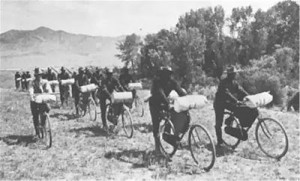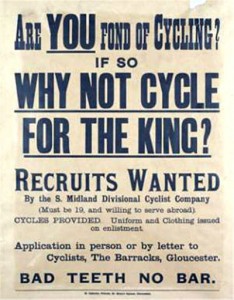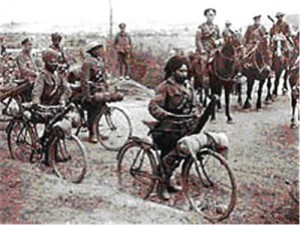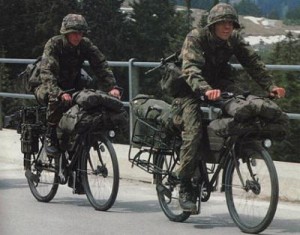 The Colonel of the 1st Cycle Infantry by Frederic Remington Photo oldbike.eu
The Colonel of the 1st Cycle Infantry by Frederic Remington Photo oldbike.eu by Yankee Papa
The SOG team was in Laos, awaiting extraction. NVA “headhunter” units were narrowing down their search… It was only a matter of time…and it was running out for the team.
They had requested extraction, but FAC pilot was radioing information to them… asking odd questions… and the general drift seemed to be that somehow the team had become the focus of not just SOG command, but far higher up.
No confirmation yet on extraction and it seemed that command was less concerned about them than obsessing over a captured NVA bicycle…
…………………
It was a dark night in February 1942 when British paras were dropped eight miles from their target. At Arnhem in 1944 this would prove a disaster to the 1st British Para Division… but tonight it was necessary.
The Germans had a radar installation on a high plateau near the coast and the British needed to capture it, inspect it, take parts with them and destroy the rest.
Commando raids at the foot of the bluff ruled out as both costly and unlikely to succeed… and a para drop on the site would likely provoke a massive and too timely influx of the many German units in the area.
A bomber raid elsewhere provided a distraction while the paras were dropped unnoticed. Eight miles… as much as three hours on foot. But they jumped with folding bicycles.
In a relatively short time they had quietly pedaled to the site and launched their assault on the radar site and the nearby estate. They completed their mission and fought a rear guard action down to the beaches where they were extracted by the Royal Navy.
………………
Bicycle troops are often viewed by American military historians as a “flash in the pan”, a “gimmick” or a brief phenomenon that quickly became outmoded.
Say it is 1914 and you have an infantry battalion that is needed 50 miles away. You have the brief use of two trucks… You can truck maybe a platoon in a couple of hours with little room for supplies.
You can load the trucks with ammunition and other supplies and have the troops march to their destination. Assuming a reasonable road… maybe arrive in something under 48 hours…and hope that supplies are still there.
But since your battalion is bicycle infantry, they will be there (assuming reasonable road) in well under 5 hours… and in condition to fight. The two trucks arrive shortly after and offload enough supplies to give your unit staying power.
In 1914 an average infantry battalion could make 20 miles a day… maybe five more if pressed. Bicycle infantry could routinely make 60 to 80 using only a fraction of the energy.
There were obvious limits to the use of these troops. With a few odd exceptions, they could not play “cavalry” and charge mounted into heavy action. They were more like light mounted infantry.
As with paras, barring resupply, their staying power was limited. But within those limitations they could accomplish a lot.
……………..
Serious interest in bicycle infantry goes back to the Franco-Prussian war of 1870-71, but the bicycle was simply not up to the demands. Too heavy, too unreliable, hard to maneuver and damaging to the spines of troops when used over extended periods… and almost impossible to move any distance over rough terrain.
Italian Bersaglieri experimented with bikes, initially for dispatch riders. Later bicycle troops were used in large scale maneuvers to good effect. In 1888 a giant advance was made with the invention of pneumatic tires.
The United States Army got involved in serious research in the early 1890s. The Connecticut National Guard issued bicycles to some of its troops.
But it was the 25th Infantry (Black enlisted) in Montana that really gave the bicycles their first hard testing. In July 1896 Lt. James A. Moss and the “Infantry Bicycle Corps” (less than a platoon) traveled from Fort Missoula to St. Louis Missouri in 34 days… most of it overland. The terrain was often nasty, but only one bicycle was knocked out of action.
American and European armies experimented with “ambulance bikes” (see photo…) Later experiments in laying and recovering telegraph and before long, telephone lines.
The Austrians and French both developed folding bikes that could be packed over gnarly terrain and then ridden on better ground. The Americans experimented with a Colt Machine Gun on one model.
The 25th Infantry made it to Cuba… but after the fighting over. But they still were able to prove their bike units. Riots in the cities resulted in bike units being deployed. They could make it through the narrowest alleys at great speed. High command was most impressed.
But the real test would come in the Boer War in South Africa. British and Commonwealth infantry deployed some units on bicycles. These were largely new and lighter models. Much of their use was cross country.
The results were good. Across roadless terrain on the veldt bike troops could make between 40 and 60 miles per day.
By the eve of WWI, Russia, Belgium, Switzerland, France, Germany, Italy and Britain all had some infantry assigned to bicycle units.
In WWI the British supplied 100,000 bicycles, the French and Belgians 150,000, and Germany 250,000. The American Expeditionary Force used 29,000… but had no designated bicycle troops.
In the early days there were many successes by bicycle troops, but the Belgian raids on German support facilities behind the lines were most effective. The Germans also used a bicycle brigade that was successfully used to invade an island in the Baltic.
Few people are aware of the brilliant guerrilla warfare waged in East Africa by General Lettow Vorbeck in WWI that ran the British ragged until the end of the war. Vehicles soon broke down but bicycles gave yeoman service.
After WWI, the bike got a workout in Ireland. The rebels against the British found that they could quietly approach in darkness… hit… and be gone… quickly to paths that vehicles could not use. In daylight the frames proved useful for all types of smuggling.
As WWII approached it seemed that only the Americans had no interest in bicycle troops. Part of that the American love of the combustion engine… We had the most, so why bother with bicycles?
Another strike against the bicycle in America was that while you can overload a soldier, there is a limit beyond where a bike will simply fail to move. Perhaps, subconsciously commanders resented this limit on their ability to load infantry like mules.
In Europe, automatic weapons and explosives had gotten lighter…opening up new possibilities for bicycle troops. Even chemical weapon bike troops raised… with chemical detection kits built into the frames.
Many people these days imagine the Germans in WWII with many armored divisions. In fact the vast majority of their artillery and supplies were horse drawn outside of the relative handful of armored and motorized divisions.
Just on the Russian front the Germans lost over a million and a half horses. From the beginning there was a place for bicycle troops.
In Norway it was a close run thing for the invaders. Bicycle troops proved to be a key to dealing with roadblocks… going around on mere paths to hit the enemy from the rear.
The British trained their paras to use folding bicycles. The Americans trained one Army para unit to use folding bikes, but it was never sent overseas.
The Russians had special bicycle units. Their bicycles had wider tires more like a modern mountain bike. Uniquely, each rider had an attached attack dog. They could maintain the same rate of speed… patrol large areas… and at night the rider could sleep knowing that the dog would wake at the slightest noise.
The Chinese had many guerrilla units equipped with bicycles. So too the French resistance. They took it up a notch from the Irish rebels. They had bikes rigged up as bombs to park among the Germans.
The Japanese had the prize entry when it came to using bicycle troops. Outnumbered, they fought down the length of Malaya and ultimately took Singapore.
Yamashita’s bike troops would hit a British or Indian roadblock… send a handful of riders through the jungle around behind British lines… throw firecrackers… convince the Brits that they were under attack from the rear. A new retreat would begin.
The cyclists would hit a small stream, maybe shoulder deep to the Japanese. Some of their men would get in the water and support boards while the troops took their bikes across.
The Japanese did not have it all their own way. Robert Leckie in “Strong Men Armed” explains why there was no counterattack the first night at Tarawa. The largely inadequate shelling had somehow managed to knock out the Japanese comm lines. The Japanese commander was hamstrung…
“…runners would be picked off. There were, of course, dozens of bicycles at his disposal, but bike-riding messengers (across open coral sand) would only provide these uncouth Marines with jokes as well as targets.”
The Marines had a para battalion and even had folding bikes. The Marines made it to the Pacific, the bikes did not.
Any account of bicycles in war needs to mention their use by the Viet Minh in the First Indo-China War and of the NVA in the later war with the Americans.
While romantic tales might cause one to believe that bikes loaded with supplies kept the Vietnamese war effort going, the truth was a bit more complicated.
Actual roads were built in both wars… In the later war ships were unloaded in Cambodia and supplies sent close to the Vietnam border by truck. But as you got closer to the war zones, bicycles took up much of the load.
At Dien Bien Phu the French Commander, General Navarre seriously underestimated the amount of supplies that the Viet Minh could move on a single bike. He estimated 2.5 times the individual’s weight. Figure 100 lb Vietnamese… so 250 lbs of supplies.
The Vietnamese reinforced the bikes and attached a long bamboo steering/brake rod. Maximum weight of cargo… 500 lbs (see photo). So 1000 men could transport 250 tons.. 10,000 could transport 2,500. If supplies needed urgently, the load was lightened.
As the wars went on a team of riders would only go so far on the trails. They would then ride their empty bikes back up the trail…and hope for no grief from the air. Half million dollar aircraft would try to knock out $20. bicycles. But with little more than 18″ wide ground trail needed, the bikes were usually under cover.
The riders would rest briefly and do it all again. The VC also used bicycle bombs in Saigon and elsewhere.
But bicycle troop were on the decline. The Swiss kept their bicycle infantry until 2003.
……………………….
And the SOG team in Laos? Ah yes. That story has been told many times, each more embellished than the last… to where it has become a legend (one version even including black helicopters!) I have the authoritative version here.
In the book “SOG, The Secret Wars Of America’s Commandos In Vietnam” the story is told by John Plaster, an Army Major who was a staff NCO in those days.
The team was led by a man called “Cooper” by the author. He was a good soldier and a good leader, but he learned a lesson about the ease of being misunderstood in radio comms that day.
The team’s only contact had been one NVA with an old bike. They meant to kidnap him, but one of the Nung tribesmen who was part of the team accidentally shot him.
It was time to extract the team. Cooper got on the radio. He encrypted his report and sent it. He was disgusted that his mission a bust and decided to take the bike with him as a souvenir.
He mentioned it in the message (“Have captured bicycle…”) but of course did not bother to encrypt the word “bicycle…” Message sent to FAC who relayed it to Ban Me Thuot where it was decrypted.
Fellow there did not know that Cooper meant an actual bicycle. Tried to look it up in code book…nothing. Tried older code book… Bingo. Bicycle was code word for a “General”.
The decrypter knew that he had to pass that up the line… even as it went higher, one command level insisted that he have FAC confirm with Cooper that he had North Vietnamese “bicycle…”
FAC sent inquiry. Cooper replied “Probably North Vietnamese… *might* be Chinese…” Command got excited and each level wanted repeats. “Cooper” was in a bad spot if extraction did not come soon. Severely annoyed by repeated questions about a stupid bicycle.
He advised FAC that if no extraction soon he would “destroy bicycle” and his team would move to evade hunter groups. Immediate order came down categorically forbidding him to destroy bicycle unless imminent danger of it falling into enemy hands.
Before the choppers arrived, Cooper was notified that the first chopper was for the bicyle only. The first chopper arrived, ready to take on the “bicycle…” When bike was produced doubtless a cascade effect took place up the chain of command.
The bicycle spent the rest of the war at the compound at Ban Me Thuot…
-YP-
Recommended Reading
The Bicycle in Wartime: An Illustrated History (Revised Edition) by Jim Fitzpatrick
Bicycles in War by Martin Caidi















